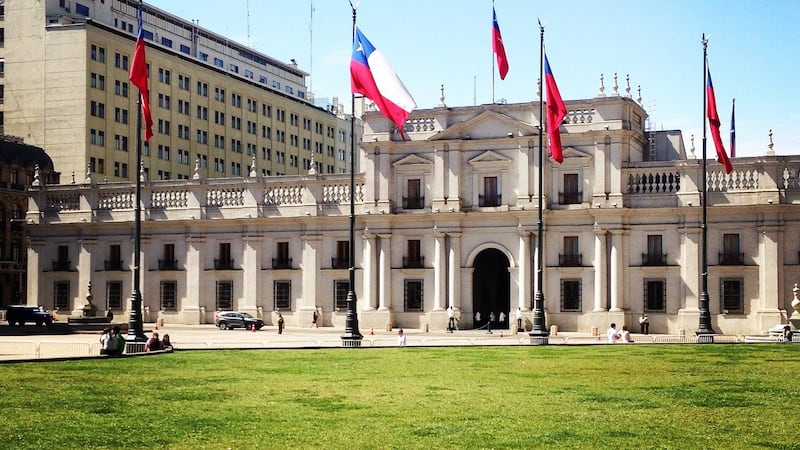A recent visit to Ireland by Chile's foreign minister Heraldo Muñoz led to several important developments in relations between the two countries. An agreement was signed by Minister for Foreign Affairs Charlie Flanagan and his counterpart Muñoz that will allow Chileans aged between 18 and 30 to spend a year working or studying in Ireland, and Irish citizens of the same age to do likewise in Chile.
The news was particularly well received in Chile, where it was reported in several of the main media outlets. Ireland is quite well regarded in the South American nation. Our popularity mostly stems from the Irish figures who played a part in the country’s winning of independence from Spain and, more recently, due to President Michael D Higgins’ role as an observer during the plebiscite that brought a democratic end to general Augusto Pinochet’s dictatorship. He was involved in supervising the crucial balloting process during the 1988 vote.
Higgins’ participation in Chile’s transition to democracy was recognised by the Chilean government during an event in Trinity College last week. The President received an honour for the contribution he made to human rights in the country.

Given the good feeling between the two countries, and the new working holiday visa on offer, there couldn't be a better time for Irish people to consider spending a year here. So what has Chile got to offer?
1. It’s safe
Firstly, and quite importantly if you wish to spend a year here, Chile is very safe. It has the lowest murder rate in the region and kidnappings are almost non-existent. Petty theft does occur, but not to the same extent as in other Latin American states. Chile’s climate does not allow for the cultivation of the coca plant used in the production of cocaine, and the absence of a large-scale drug trade also contributes to the country’s security.
2. Climate
Santiago, the capital, enjoys Mediterranean style weather, without the high humidity levels of cities like Buenos Aires or Rio de Janeiro. Rainfall is a rare occurrence. The temperatures never reach the scorching heights of Australia, but linger around the mid to high 20s for most of the year. The winters are mild with plenty of sunshine.
3. Lots to do
Many will know of Chile as the longest country in the world; stretching for 4,300km the landscape is extraordinarily varied. From sandboarding in the Atacama Desert in the north, to scaling the ice-capped volcanoes in the south, there is plenty of different activities on offer for travellers. Skiing is possible in the Andes, while the Pacific coast features endless beaches where surfing is becoming a popular pastime. Cheap internal flights and good bus services make these activities very accessible.
4. Top class universities
Chile is home to some of the continent’s best universities, many of which offer courses for international students. I first came to the country on an exchange during my undergrad to learn Spanish, returning a year and a half ago to study for a master’s degree in International Studies, and I’d highly recommend the experience. Under the working holiday visa arrangement, Irish students can also take time to study here, which could be a great opportunity to learn a new language and add some international experience to your education record.
5. Interesting jobs
If you are finished your studies, then there are plenty of jobs to be found too. Despite recent economic struggles, such as the end of the commodities boom and the subsequent fall in copper prices, Chile still hosts one of the most advanced economies in Latin America. There are plenty of skilled jobs on offer and Santiago is home to many multinational companies. Start-Up Chile is an initiative run by the Chilean government encouraging tech start-ups to come and build their companies in the capital. Many of these fledgling companies have a great need for English speakers. Fluent English also opens a lot of doors in the teaching and tourism sectors.
6. Food and wine
Chilean cuisine is admittedly not the most sophisticated, but then again, neither is our own. Indeed, there are even some similarities: Chileans love stew. In general, it is good hearty food and the portion sizes won't disappoint. Barbecues and big sandwiches are very popular, and fresh seafood dishes are excellent in the coastal cities. The tomato is a big favourite, so much so that Pablo Neruda even wrote a poem about it. The wine culture is also a big draw, and Santiago is surrounded by colossal vineyards.
7. The people
It is important to get on with the locals if you are going to spend a year among them. There are several historical similarities shared by the two countries, and this common ground seems to have given both nations a similar outlook on life. For starters, Chile is basically an island too, as it is isolated by deserts to the north and the towering Andes all along its eastern border. Chile also endured a colonial past; the Spanish Empire ruling over it for many years until it was liberated during the Bolivarian Wars of Independence. The hugely influential presence of the Catholic Church is another factor that both countries share. The decline of religious influence in Ireland is something that is being mirrored in Chile. It is these things that Chileans and Irish have in common which make communication a lot easier. They have a welcoming attitude combined with a sense of humour very much in line with our own.
You would be hard pushed to find a more interesting place to spend a year abroad.










